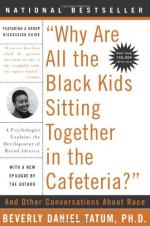
|
| Name: _________________________ | Period: ___________________ |
This test consists of 5 multiple choice questions, 5 short answer questions, and 10 short essay questions.
Multiple Choice Questions
1. What is the fifth stage of William E. Cross, Jr.'s theory of Nigrescence?
(a) Internalization-commitment.
(b) Pre-encounter.
(c) Internalization.
(d) Immersion/emersion.
2. Who signed the Civil Rights Act of 1968?
(a) James K. Polk.
(b) Ulysses S. Grant.
(c) Chester A. Arthur.
(d) Lyndon B. Johnson.
3. What means of, pertaining to, or concerned with the principles or rules of right conduct or the distinction between right and wrong?
(a) Moral.
(b) Diffusion.
(c) Tacit.
(d) Emotion.
4. In Part II, Understanding Blackness in a White Context, Chapter 3, Tatum writes that she often opens race seminars with adults by asking them about what?
(a) The degree of their parents' racism.
(b) If they have ever been a victim of racism.
(c) The most recent occurance of racism they have seen.
(d) Their first race-related memory.
5. What refers to a person who suffers from a destructive or injurious action or agency?
(a) Culprit.
(b) Victim.
(c) Analogy.
(d) Martyr.
Short Answer Questions
1. What refers to a similarity between like features of two things, on which a comparison may be based?
2. What refers to a simplified and standardized conception or image invested with special meaning and held in common by members of a group?
3. According to the author, the main source of self-segregation seems to arise during what developmental stage?
4. William E. Cross, Jr. is a professor and head of the doctoral program in social-personality psychology at what institution?
5. Tatum writes in Part II, Understanding Blackness in a White Context, Chapter 3 that at very young ages, children are often confused by the color language due to their encounters with what?
Short Essay Questions
1. How does the author describe white privilege in Part I, A Definition of Terms, Chapter 1, Defining Racism? What is problematic in addressing these issues?
2. How does the author relate personal identity to the surrounding social group in Part I, A Definition of Terms, Chapter 2, The Complexity of Identity?
3. How does the author address the subject of slavery when dealing with children in Part II, Understanding Blackness in a White Context, Chapter 3, The Early Years?
4. What is Tatum's argument against those who suggest keeping silent regarding race with children in Part II, Understanding Blackness in a White Context, Chapter 3, The Early Years?
5. How does the author describe reverse racism in Part I, A Definition of Terms, Chapter 1, Defining Racism?
6. Why does the author claim that when addressing racism with children it is important to keep in mind their developmental stage in Part II, Understanding Blackness in a White Context, Chapter 3, The Early Years?
7. What analysis of William Cross's does the author describe in Part II, Understanding Blackness in a White Context, Chapter 4, Identity Development in Adolescence?
8. How did Tatum feel about her experiences while in college, as discussed in Part II, Understanding Blackness in a White Context, Chapter 5, Racial Identity in Adulthood?
9. When in an individual's life does the impact of racism begin, according to the author in Part I, A Definition of Terms, Chapter 1, Defining Racism? How is it developed?
10. What co-evolving processes construct personal identity according to the author in Part I, A Definition of Terms, Chapter 2, The Complexity of Identity?
|
This section contains 1,003 words (approx. 4 pages at 300 words per page) |

|




